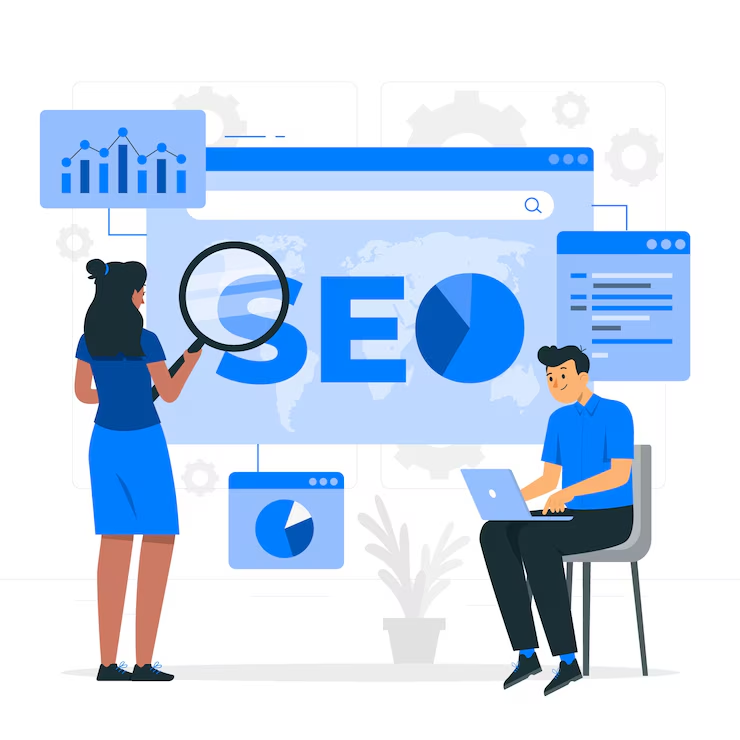
In today’s competitive digital world, ranking on the first page of Google is not a luxury — it’s a necessity. The Power of SEO: How to Rank Your Website on the First Page reveals the essential strategies and techniques that drive real, lasting results. From mastering on-page optimization to building high-authority backlinks and leveraging the latest tools, this guide empowers you to climb search engine rankings and dominate your niche. Whether you’re a startup or an established brand, unlocking these strategies can exponentially boost your traffic, credibility, and revenue. Get ready to transform your online presence!
Search engine optimization is not dead — it’s more important than ever in 2025! This blog will explain why it still matters for every website and business today. You’ll learn how these strategies help you get more visitors, build trust, and stay ahead of your competition. Whether you’re running a small blog or a big company, understanding this can make a huge difference. Stay updated with the latest trends and tips to keep your website ranking high and growing strong!
Brief explanation of SEO
Search engine optimization stands for making your website better so that it ranks higher on search engines like Google. The higher your site appears, the more people can find and visit it. This includes improving your content, using the right keywords, speeding up your site, and getting trusted websites to link to you. In short, it helps your website become more visible, trusted, and successful online!
The value of organic traffic vs. paid traffic

Organic traffic comes from people who find your website seo naturally through search engines, while paid traffic comes from ads you pay for. Both are important, but organic traffic often brings more trust, long-term results, and better engagement without ongoing costs. Paid traffic, on the other hand, gives faster results but stops when you stop paying. Understanding the balance between organic and paid traffic can help you build a strong, steady flow of visitors and grow your business the smart way.
Latest Google algorithm updates (brief mention)
Google frequently updates its algorithm to improve search results and user experience. These updates affect how websites are ranked on search pages. Recent changes in 2025 focus more on helpful content, mobile-first indexing, page experience, and AI-driven search behavior. Even small updates can impact your rankings, so staying informed and adapting your SEO strategy is essential. In this section, we briefly highlight what’s new and why it matters for your website’s performance.
Understanding How Search Engines Work
Understanding how search engines work is the first step to building a strong SEO strategy. Search engines like Google use bots to crawl web pages, index their content, and rank them based on relevance, quality, and user experience. Important SEO factors such as keywords, backlinks, mobile-friendliness, and page speed all play a role in how your site is ranked. When you know how search engines find and rank websites, you can optimize your content more effectively and improve your chances of reaching the first page of search results.
- How Google indexes and ranks pageshttp://trigundigitalcompany.com
- Google indexes and ranks pages through a process that begins with crawling. Googlebot, a web crawler, visits websites, scans content, and stores it in Google’s index. When a user performs a search, Google’s algorithm evaluates indexed pages based on hundreds of factors like relevance, keywords, quality of content, backlinks, and user experience. The more optimized your page is for these factors, the higher it will rank in search results. Understanding this process helps you align your SEO strategy to improve visibility and drive more organic traffic.
- Importance of crawling and indexinghttps://deepanshubisht.in/

- Crawling and indexing are fundamental to how search engines discover and rank your website. Crawling refers to search engine bots, like Googlebot, exploring your web pages and following links to gather information. Indexing is the process of storing and organizing that information in the search engine’s database. Without proper crawling and indexing, your website’s pages may not appear in search results. Ensuring your site is easily crawled and indexed helps improve visibility and search engine rankings, making it a crucial part of your SEO strategy.
- What is SERP and how it is structured
- SERP stands for Search Engine Results Page, which is the page displayed by search engines after a user enters a query. The SERP includes both organic and paid search results. The organic results are based on relevance to the search query, while paid results appear as ads. The SERP also features other elements like featured snippets, knowledge panels, and local packs, which enhance the user experience. Understanding SERP structure helps you optimize your content to improve visibility and increase your chances of ranking higher on Google
On-Page SEO: Building a Strong Foundation

In today’s digital world, ranking on the first page of Google is crucial for your website’s visibility. On-Page SEO involves optimizing web pages with targeted keywords, meta tags, site speed, mobile responsiveness, and structured content. A solid on-page SEO strategy helps search engines understand your content and enhances user experience, setting the stage for long-term success. The Power of SEO: How to Rank Your Website on the First Page guide equips you with essential strategies to boost traffic, credibility, and revenue through mastering SEO. Stay informed and adapt your strategy to leverage small updates for improved rankings. Understanding how search engines work is vital for refining your SEO approach and increasing your chances of ranking on the first page of search results.
Understanding On-Page SEO
On-page SEO refers to the practice of optimizing various elements on a website to improve its search engine rankings and enhance overall user experience. It encompasses numerous strategies and practices that ensure both search engines and users can effectively navigate and understand a webpage’s content. By focusing on the intricate factors that affect a webpage’s performance, on-page SEO becomes an essential component of an effective digital marketing strategy.
Core components of on-page optimization include the utilization of relevant keywords, implementation of meta tags, organization of headers, and maintenance of high-quality content. Keywords serve as the foundation for on-page SEO, helping search engines identify and rank the relevance of a webpage based on user queries. By conducting thorough keyword research and strategically placing these terms within the content, website owners can significantly impact their visibility on search engine results pages (SERPs).
Meta tags, which consist of title tags and meta descriptions, play a pivotal role in on-page optimization. A well-crafted title tag communicates the main topic of the webpage, while a compelling meta description entices users to click through to the site. These tags not only aid search engines in comprehending the nature of the content but also impact the click-through rate, which is crucial for driving traffic to the website.
Headers, such as H1, H2, and H3 tags, help structure the content on a webpage and signal to search engines the hierarchy of information presented. They enhance readability by breaking up text and allowing users to scan the page easily. Furthermore, content quality is critical in on-page SEO; engaging, informative, and well-written content increases the likelihood of user retention and generates backlinks, further solidifying a webpage’s reputation and authority within its niche.
Ultimately, effective on-page SEO not only enhances user experience by delivering quality information in an easily digestible format but also improves search engine visibility. This dual focus underscores the necessity of on-page optimization in any comprehensive SEO strategy.
Key Elements of On-Page SEO
On-page SEO forms a critical component of digital marketing, equipping web pages to rank favorably on search engines. Understanding the key elements of on-page SEO is essential for establishing a strong foundation for any online presence. One of the most fundamental practices is thorough keyword research. Identifying relevant keywords and placing them strategically within content helps search engines understand the context of a web page, making it important to incorporate these keywords naturally throughout the text, including the introduction, body, and conclusion.
Another critical element is the effective use of title tags and meta descriptions. The title tag serves as the main headline for a webpage, appearing prominently in search results, and should ideally include the focus keyword. Similarly, meta descriptions provide a concise summary of the page’s content and can influence click-through rates; therefore, optimizing both the title tag and meta description with relevant keywords is vital for enhancing visibility.
The structure of header tags (H1, H2, H3, etc.) also plays a significant role in on-page SEO. Header tags help create a hierarchical structure for content, making it easier for readers to digest information. The H1 tag typically encompasses the main title of the page, while subsequent headers should mirror the content’s organization. Properly utilizing header tags can improve user experience while signaling to search engines the main topics discussed on the page.
Image optimization is often overlooked in on-page SEO but can enhance viewer engagement and site speed. Including alt text that describes the image while incorporating relevant keywords can aid in improving search rankings. Lastly, internal linking strengthens the website’s structure, guiding users to related content while distributing page authority throughout the site. By comprehensively applying these elements, website owners can systematically enhance their pages for both user experience and search engine performance.
Best Practices for Effective On-Page SEO
Implementing effective on-page SEO requires attention to several critical practices that contribute to a website’s overall performance in search engines. High-quality content is at the forefront of on-page SEO best practices. It is essential to create content that addresses user intent, provides valuable information, and answers the questions that users have. Doing so not only improves engagement but also boosts the likelihood of attaining favorable search engine rankings.
Moreover, optimizing for mobile devices is a fundamental aspect of on-page SEO, especially as mobile searches continue to increase. Websites must be responsive and designed to provide an excellent user experience across all devices. This can include ensuring that text is legible on smaller screens, images are properly scaled, and navigation is user-friendly. Google places a high emphasis on mobile-friendliness, making this practice crucial for any successful on-page SEO strategy.
Another critical aspect of effective on-page SEO is ensuring fast loading times. Users are likely to abandon a website that takes too long to load, which can lead to higher bounce rates and negatively impact a site’s search rankings. Techniques such as compressing images, leveraging browser caching, and minimizing server response times can significantly enhance a webpage’s loading speed.
Enhancing readability is also vital in implementing on-page SEO. This involves using clear headings, bullet points, and short paragraphs to make content more digestible. The readability of your content can directly influence user engagement, making it crucial for lowering bounce rates and increasing the time spent on the site.
Finally, tracking and measuring the effectiveness of your on-page SEO efforts is paramount. Utilizing analytics tools can provide insights into user behavior, traffic sources, and performance metrics, enabling a data-driven approach to continuous improvement. Employing these best practices will lay a solid foundation for successful on-page SEO and contribute to achieving online visibility and growth.
Common Mistakes to Avoid in On-Page SEO
On-page SEO is critical for enhancing website visibility and improving search engine rankings. However, several common mistakes can undermine these efforts and ultimately affect a website’s performance. One prevalent error is keyword stuffing, which occurs when a writer excessively uses target keywords in the content. While optimizing for specific terms is essential, overuse can lead to poor readability and may result in penalties from search engines. Striking the right balance by naturally incorporating keywords in a way that serves the users’ intent is essential for effective on-page SEO.
Another frequent mistake is neglecting user experience. Websites should be designed with the user in mind, ensuring that they are easy to navigate and visually appealing. If a website is cluttered or slow to load, it can drive visitors away, potentially impacting search engine rankings. On-page SEO strategies should include optimizing images, utilizing clear calls-to-action, and ensuring mobile-friendliness to create a favorable user experience.
Poor URL structures can also be detrimental to on-page SEO. URLs should be concise, descriptive, and relevant to the content they represent. Complicated and lengthy URLs can confuse users and search engines alike, making it challenging to understand the context of the page. Crafting clean and keyword-rich URLs will contribute positively to the overall optimization efforts.
Lastly, many websites overlook the importance of updating old content. Search engines favor fresh, relevant information; thus, regularly reviewing and refreshing existing posts can improve rankings and enhance a website’s credibility. Maintaining an effective on-page SEO strategy involves addressing these common pitfalls to build a robust foundation that supports digital marketing goals.


